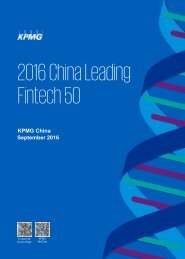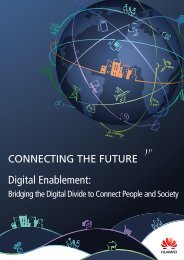Challenge One: Popular conceptions of governanceecosystems tend <strong>to</strong> be overly reductive and can hinderthe strategic targeting of efforts.Governance outcomes are determined by the relationships andinteractions between ac<strong>to</strong>rs of complex, dynamic ecosystems.Within governance data communities, the commonly used categoriesof ‘data producer’ and ‘data consumer’ represent a convenient buttheoretical division of those who may engage with governance data.In practice, the relationship between such ac<strong>to</strong>rs is not so neatlydefined. Use of these labels prevents an accurate understanding ofgovernance ecosystems and the chain of events that influencedifferent decisions.Current discourse also tends <strong>to</strong> assume that ‘users’ are <strong>to</strong> be‘designed for,’ rather than recognizing that there is a range of ac<strong>to</strong>rswho might be recruited, trained, lobbied, serviced, supported, orotherwise engaged <strong>to</strong> influence governance outcomes.The labels of ‘producer’ and ‘consumer’ are false binariesand should be discarded.Rather, it is necessary <strong>to</strong> map the range of ac<strong>to</strong>rs who haveinfluence —formal and informal— over a specific governance issue,and <strong>to</strong> understand how their respective his<strong>to</strong>ries, interests, andrelationships intersect and collectively shape outcomes. This processhelps identify ac<strong>to</strong>rs with significant influence on a particular issue,whether due <strong>to</strong> individual positions or <strong>to</strong> accumulated authorityfrom being at the nexus of networks or processes. Such ac<strong>to</strong>rsshould be targeted as priority data users.Blurring the Lines Between <strong>Data</strong> Providers and ConsumersStudy respondents, for the most part, rejected the labels of ‘data production’ or ‘data consumption’when describing their work around governance data. A few described starting their journeysin governance data as ‘data users’ that sought out and used data for a specific purpose. Overtime, they began <strong>to</strong> package and share their interpretations of the data they’d collected and, inthe process, became ‘data producers.’One member of a successful government watchdog group explained how, over a decade, thegroup grew from being a gatherer of governance data <strong>to</strong> a leading national producer of originalanalysis <strong>to</strong> inform diverse advocacy efforts.The organization was founded by a group of journalists that wanted <strong>to</strong> share information in suppor<strong>to</strong>f their investigative reporting. To assist with its own work, the group began capturing informationit received from the government in response <strong>to</strong> its filed Freedom of Information requests.Its own capacity, however, only went so far in identifying suspicious patterns in received data;consequently, the journalists sought support <strong>to</strong> expand their audience. The group opened access<strong>to</strong> its data, with a focus on corporate influence and procurement data. Over time, it developed anopen data portfolio which includes <strong>to</strong>ols for data mapping and analysis.Today, the organization positions itself as an advocacy group that provides access <strong>to</strong> data, andthat uses data <strong>to</strong> inform its own government engagement. As one staff member explained, “Ouropen data projects seek <strong>to</strong> not only create our own internal cases for fighting corruption, but <strong>to</strong>also generally provide data <strong>to</strong> others [<strong>to</strong> achieve the same goals].”Governance data communities tend <strong>to</strong> refer <strong>to</strong> ‘users’ in broad categories,such as “government,” “private sec<strong>to</strong>r,” “civil society,” “media,” and others.Recognizing the heterogeneity within each category, and identifying priorityac<strong>to</strong>rs within them, will be critical <strong>to</strong> designing data products that advancethe desired impact.While segmenting by sec<strong>to</strong>r helps describe the potential universe of governancedata users, further specificity is needed <strong>to</strong> determine which ac<strong>to</strong>rs aremore influential and hence priority targets.5
Challenge Two: Governance ecosystems are complicated by fac<strong>to</strong>rs notusually acknowledged in strategic planning and program design processes.Such fac<strong>to</strong>rs include government incentive structures and political volatility.Respondents surfaced many specifictypes of users that fall under the broad,sec<strong>to</strong>r-based, classifications. This can helpdata providers better understand who theyare designing for, how <strong>to</strong> appeal <strong>to</strong> theirincentives, and how <strong>to</strong> help them integratedata in<strong>to</strong> existing activities and processes.Such an exercise will also lead <strong>to</strong> greaterdefinition of target users beyond thesec<strong>to</strong>r-based categorizations that are<strong>Data</strong> UsersCertain governance data users aremore influential than others.Identifying them requires addinggranularity <strong>to</strong> commonly used,sec<strong>to</strong>r-based categorization.Some examples surfaced byrespondents include:GOVERNMENT• Electedofficials• Civil servants• Reformers• LawenforcementInfluential Ac<strong>to</strong>rsRather than breaking the governance dataecosystem along traditional ‘supply’ and ‘demand’divides, it is more useful <strong>to</strong> categorize ac<strong>to</strong>rsbased on their degree of influence over targe<strong>to</strong>utcomes. Influential governance data ac<strong>to</strong>rs tend<strong>to</strong> come from specialized or niche groups, andvary across a number of dimensions.currently in common use. A more granularunderstanding of ac<strong>to</strong>r categories willallow for more effective engagement. Thequestion then is not, “How do we reach‘users’?” but rather, “Of all the possible ac<strong>to</strong>rsthat may use governance data, who has themost influence over decisions on this issueand how are they exercising that influence?How can we source, package, and share data<strong>to</strong> encourage them <strong>to</strong> fit governance datain<strong>to</strong> their existing work?”CIVIL SOCIETY MEDIA PRIVATE SECTOR• Advocacy• Research• <strong>Data</strong> &technology• Investigativejournalists• <strong>Data</strong> journalists• Corporations• SMEs• Forensicauditing firmsMSI respondents generally spokeconfidently about the theoretical andtechnical dimensions of governance dataand with greater hesitation on operationalpaths <strong>to</strong>ward impact. (The politicalimplications of data production and usagewere <strong>to</strong>uched on briefly.) With few exceptions,respondents had less substantiveengagements with governments—the ac<strong>to</strong>rsthey sought <strong>to</strong> influence (i.e. as opposed <strong>to</strong>with civil society)—which contributed <strong>to</strong>a limited understanding of their interestsand capacities. This suggests a disconnectbetween how governance ecosystems andprocesses are structured and operate, andhow many governance data ac<strong>to</strong>rs understandthem.Although the ‘governance data community’is loosely defined, members fromgovernment tend <strong>to</strong> represent a minority.Of those from government, anecdotalevidence suggests that many are relativelynew <strong>to</strong> the public sec<strong>to</strong>r, reform-oriented,and, as a result, often on the peripheries ofpower and decision-making. Civil societyac<strong>to</strong>rs, while open <strong>to</strong> the idea of engagingwith government, lack systematic processes<strong>to</strong> test their assumptions and <strong>to</strong> developempirically grounded, nuanced understandingsof how government works.Peixo<strong>to</strong> (2013) notes that any accountabilitymechanism built on disclosure principlesrequires a minimal chain of events:1. <strong>Government</strong>al information is disclosed;2. The disclosed information reaches itsintended public;3. Members of the public are able <strong>to</strong>process the disclosed information andreact <strong>to</strong> it; and4. Public officials respond <strong>to</strong> the public’sreaction or are sanctioned by the publicthrough institutional means. 4Though greatly simplified, this basic modelof accountability highlights the limits ofcurrent approaches <strong>to</strong> governance data,which emphasize the first two steps in thechain and largely ignore those after. Aspreviously noted, the governance datacommunity struggles <strong>to</strong> identify ac<strong>to</strong>rs withthe interest and capacity <strong>to</strong> use discloseddata <strong>to</strong> effect change (Step 3). While thecommunity is actively grappling withthis question, current efforts do notadequately account for the complexity ofgovernance processes—and specifically,of how governments operate. As a result,they apply linear strategies <strong>to</strong> dynamicenvironments and are unable <strong>to</strong> elicitthe desired responses from government(Step 4). Challenges in identifying and targetingac<strong>to</strong>rs that have influence withingovernment frustrates the success of4 Peixo<strong>to</strong>, Tiago. “The Uncertain Relationship Between Open <strong>Data</strong>and Accountability: A Response <strong>to</strong> Yu and Robinson’sThe New Ambiguity of “Open <strong>Government</strong>”. University of LosAngeles Law Review 2013.6




